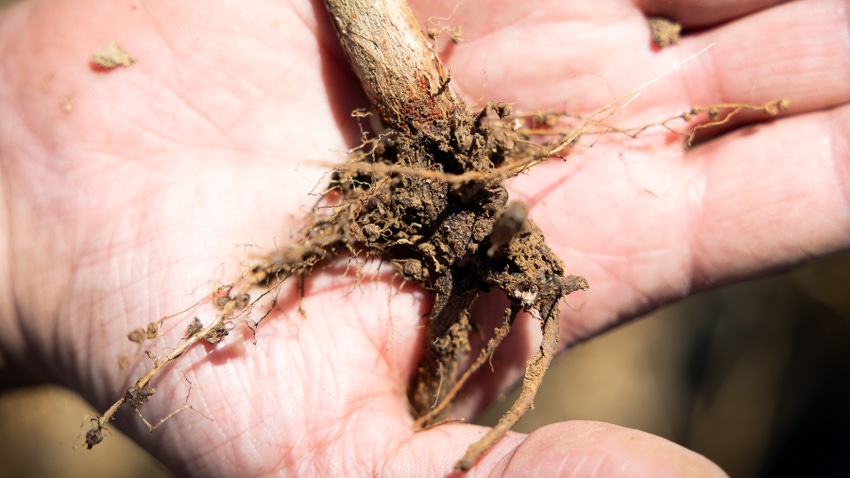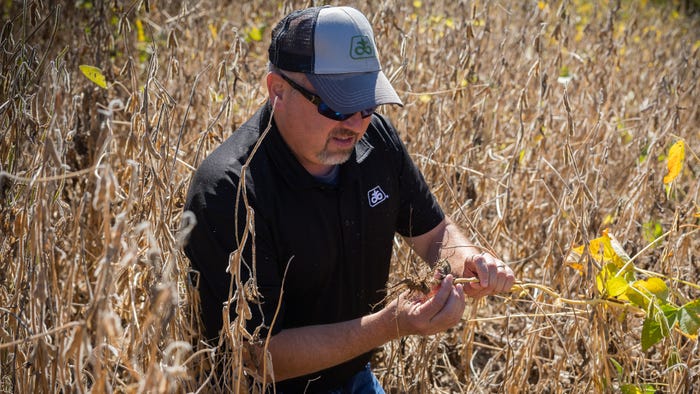May 24, 2023

Conditions are ripe in some areas of the state for red crown rot this summer — and unfortunately for some soybean growers, the disease already may have taken hold.
Red crown rot is a relatively new disease to the Midwest but is known to occur in Southern states as a peanut disease and occasional soybean disease. The pathogen that causes red crown rot thrives on legumes, several ornamental species and some native plant species.
Red crown rot was first documented in Illinois in Pike County in 2018 by Nathan Kleczewski. At the time, Kleczewski was a crop scientist at the University of Illinois but is now a plant pathology and insect specialist for Growmark.
A grower had sent him photos of the damage, and Kleczewski immediately knew it was red crown rot from his encounters with the disease while working in Delaware.
“The field was just wrecked,” Kleczewski says. “It was horrible. Many plants had a melted look to them.”
Kleczewski says because of its severity, red crown rot has likely been in Illinois for more than five years, but prior to 2018 may have been misdiagnosed as sudden death syndrome.
“One of the things we’ve talked about is how alarming the yield loss can appear over a wide area in a short period of time,” explains Matt Montgomery, agronomist for Pioneer. “That’s raised a lot of eyebrows and has generated some concern about what this might mean for the future.”
Signs of red crown rot infection
Red crown rot infects seedling soybeans in the first three weeks after germination. If infection is severe, growers may start to notice thinner stands, but foliar symptoms and plant death won’t be evident until August or September. Kleczewski says if red crown rot infects early enough in the season, growers can see yield losses approaching 50% in severely affected areas of the field.
Red crown rot shares many similarities with SDS. In both diseases:
Infection occurs in the first month of a plant’s life, within three weeks of germination.
Interveinal chlorosis occurs after pod set. Look for green veins on foliage while remaining tissue turns yellow to brown.
Cryptic infection occurs.
Wet soils around planting are favorable.
Soilborne organisms overwinter in the field.
Survival can occur in the soil for over a year without soybeans present.
Characteristics specific to red crown rot include:
Brick-red spheres, or fruiting structures, appear near the base of the stem.
The pathogen prefers warm soils and may be more prevalent in later plantings.
“The biggest difference is that the pathogen that causes red crown rot tends to like warm soils and the pathogen that causes sudden death syndrome does better in cool soils,” Kleczewski says. “Sometimes you’ll see both in the field if there are moderate temperatures, as both diseases can do fairly well, provided that there has been sufficient soil moisture.”
Red crown rot in the Midwest has been spotted in western Illinois near the Iowa and Missouri borders, in central Illinois around Springfield, and in parts of Kentucky — causing the plant science community to scratch their heads about its unusual distribution pattern.
Kleczewski speculates that the disease could be lurking in neighboring states, like Missouri and southern Indiana, but has yet to be documented.
Disease management
Currently, it’s unknown which fungicides best manage red crown rot.
“We are at the very forefront of trying to get our heads around how to best manage this pest,” Montgomery says. “We’ve got some ideas, but we would like more tools than what we have at the moment.”

ROOTS: Matt Montgomery of Pioneer digs soybean roots with red crown rot damage in a Pike County, Ill., field. Because little is known about which fungicides can effectively combat the disease, Montgomery says, “all management techniques are a little bit uncomfortable. It seems like kind of an equal-opportunity disease.”
For the 2023 growing season, Kleczewski expects both red crown rot and SDS pressure, depending on when soybeans were planted.
“I would expect red crown rot to be a problem in areas with known pressure, especially where soybeans were planted late and started emerging prior to heavy rains,” he explains. “For beans planted early with the dry period during germination, I think they’re more likely to see sudden death if that disease was established in the field. It is looking like it might be a year for sudden death syndrome in many areas.”
Kleczewski says some preventative measures can be taken to ward off the threat in areas with known red crown rot pressure. He recommends:
Crop rotation. Practice crop rotation to a non-legume crop for at least one year to prevent pathogen buildup in the soil.
Early planting. Plant soybeans early, because red crown rot thrives in warm conditions and infects the plant three weeks after germination.
Seed treatment. Consider using Syngenta’s Saltro soybean seed treatment, which has been shown to provide at least a 3- to 4-bushel yield response and reduced overall damage.
“If you think you have sudden death syndrome, make sure it’s sudden death,” Kleczewski says. “Don’t just use those visual symptoms. Make sure you’re confident it’s not red crown rot, because they are different diseases with different management strategies.”
Read more about:
Balance SheetAbout the Author(s)
You May Also Like


-01-01.png?width=300&auto=webp&quality=80&disable=upscale)




